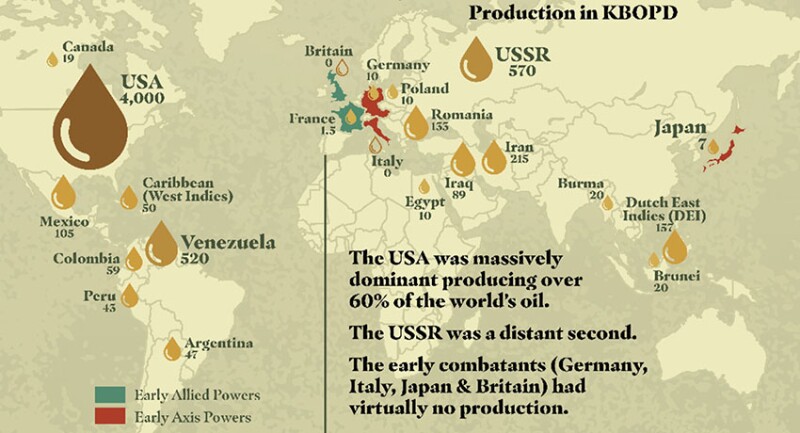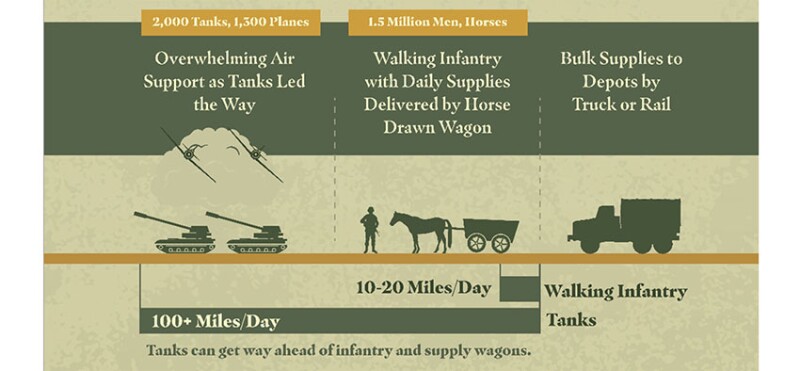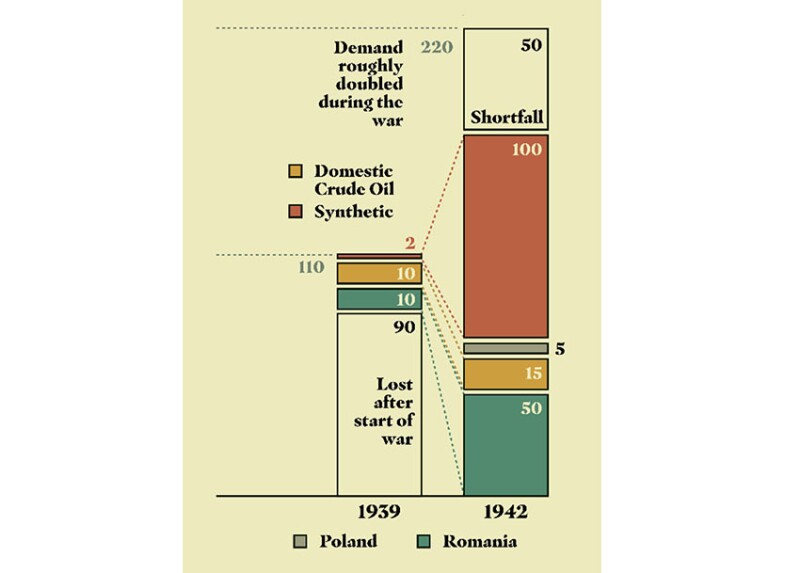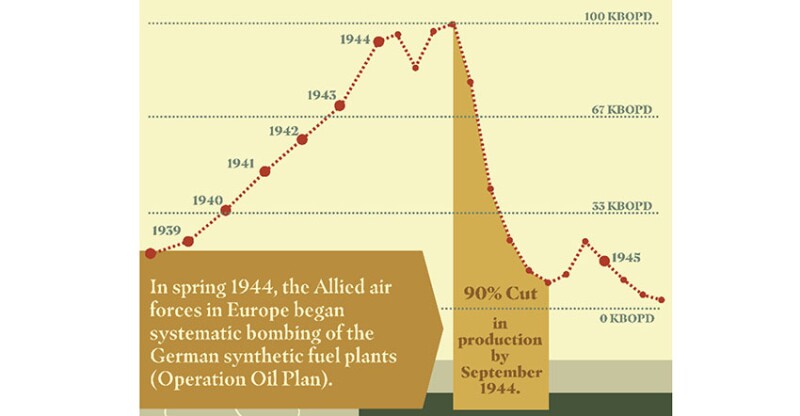In August 1944, the Third Army under George Smith Patton Jr. was forced to a standstill near the German border due a shortage of fuel.
In October 1942, German General Erwin Rommel was advancing through Egypt with the Middle Eastern oil fields “in sight” when he ran out of fuel near Cairo.
Patton was refueled in time to resume his advance. Rommel was not refueled in time. He lost his strategic advantage, and he lost the key battle of El Alamein.
In World War II (WW2), for the first time, the major armies’ frontline striking forces were completely or mostly mechanized. These armies ran on oil. Both the Allies and the Axis Powers struggled at times to provide fuel to their armies, air forces, and navies, but the struggles were very different.
Fig. 1 illustrates the oil production rates of various countries in 1940. The US was the dominant oil producer by far: 4,000 KBOPD (thousand BOPD), over 60% of worldwide production. The US supplied most of the fuel used by the Allied countries in WW2. The challenge was to get that fuel to war fronts in Europe, Africa, and Asia.

The Axis Powers had little or no production:
- Germany—10 KBOPD
- Italy—0 KBOPD
- Japan—7 KBOPD
Germany employed several strategies to secure and conserve fuel as discussed below. Japan also employed multiple strategies including taking control of the Dutch East Indies and other oil-producing countries by force.
SPE Delta Section (New Orleans) Prepares for ATCE
The “Oil in WW2” study was conducted to coincide with the 2024 SPE Annual Technical Conference and Exhibition held in New Orleans. From November 2023 until July 2024, the authors led a small team that conducted the study. The study is presented in a series of 17 freestanding panels, each 3×7.5-ft, printed on front and back (Fig. 2).

Blitzkreig With Horses
From September 1939 to June 1940 Germany defeated 10 countries. Their method of attack was termed blitzkrieg (“lightning war”). Mechanized tank divisions supported by overwhelming tactical air power made them seem invincible.
What is not as well-known is what happened behind the German lines. Tanks plowed ahead at 100 to 200 miles per day. The infantry walked 10 to 20 miles per day. And supplies, other than fuel, were delivered to the front via horse-drawn wagon at a similar speed (Fig. 3). In WW1 the German army used 1.5 million horses; in WW2 the Germans used twice as many horses.

The use of horses was necessary because Germany did not have enough trucks to deliver supplies, and even if they had, they would not have had enough fuel to run them.
Battle of the Atlantic
Germany attacked Poland on 1 September 1939. Britain and France declared war 3 days later. And Germany immediately commenced the Battle of the Atlantic, the longest battle of the war.
As noted above, Germany had very little oil production. Britain had even less. The British imported their oil, most of it from the US. In the Battle of the Atlantic, Germany sought to deprive Britain of fuel, food, and other supplies. The battle was fought largely via submarines, German U-boats.
In the years prior to war, German Admiral Karl Dönitz argued for a very large U-boat fleet; he asked for 300 of them. Adolf Hitler, the dictator of Nazi Germany, chose instead to build surface vessels. Big mistake!
With only six submarines in the Atlantic at the start of the war, Dönitz created havoc, sinking roughly 30 supply ships per month. By 1942, he was sinking 60 ships per month. If he had had anywhere near the 300 submarines he had lobbied for, Britain would likely have fallen in short order, and the course of the war would have been dramatically different.
Throughout the battle of the Atlantic the main targets of U-boats were oil/fuel tankers. 142 tankers were sunk in US waters in 1942.
The Battle of Britain and 100 Octane Gasoline
In the middle of 1940, the British were alarmed. The powerful French army had fallen in 6 weeks. The Battle of the Atlantic was causing shortages of everything, including food and fuel. A German attack was believed to be imminent, initially by air, and both sides believed the Luftwaffe to be far superior.
The British, however, had two underappreciated advantages: homefield advantage and better fuel.
British and American planes consumed 100 octane fuel; German planes burned 85 octane fuel. 100 octane fuel conveys a 30% advantage in power generation. This, along with German strategic blunders, rendered a draw in the Battle of Britain, a massive success for the Allies.
Germany Needs Fuel
During the Battle of Britain, Germany was flush with fuel, much of it confiscated from defeated countries. But that would be the last time that Germany was fuel secure.
Prior to the war, Germany consumed about 110 KBOPD. 80% of that supply was lost at the start of hostilities (Fig. 4).

Fuel consumption doubled during the war to over 200 KBOPD. Germany’s strategy for supplying fuel during the war included
- Increasing imports from Romania from 10 to 50 KBOPD.
- Dramatically increasing synthetic fuel production (from coal) from 2 to 100 KBOPD.
- Imposing harsh rationing that nearly eliminated petroleum fuel use in the civilian economy.
They were particularly successful in their miraculous increase in synthetic fuel production. But by the middle of 1942 Germany had a fuel shortfall of 50 KBOPD (Fig. 5).

Germany Attacks USSR (1941)
With Britain teetering on the brink of defeat, Hitler changed his focus to the USSR. He had several objectives: land for his people, food, industrial capacity, and, especially, oil. USSR was the second‑largest producer after the US with a capacity of 570 KBOPD, most of that in the Caucasus Mountains.
In June 1941, the Germans began the largest attack in history—4 million men! They were divided into three armies:
- Army Group North was to take St. Petersburg
- Army Group Central was to take Moscow
- Army Group South was to take the oil fields in the Caucasus Mountains
Hitler employed blitzkrieg tactics that had proved so effective in Western Europe. He believed that the USSR would fold within 2 months. He was wrong!
Blitzkrieg tactics were unsuccessful in the USSR for several reasons, including:
- Over long distances the speed of the blitzkrieg was limited by the horses. The element of surprise was lost.
- Supply problems due to long distance, a very wide front, and lack of roads.
- USSR strategy of defense in depth—when the Germany blitzkrieg broke through one line, they often faced another line and withering attacks on their flanks.
None of the three armies reached their objective in the USSR in 1941.
Germany Reaches for the Caucasus in 1942
Whereas the Germans had three objectives in 1941, in 1942 they were laser-focused on taking the Caucasus oil fields. At this point Germany was desperate for fuel.
If we don’t take Baku, we will lose the war.
They made significant progress towards the objective—until Hitler changed his mind and ordered an attack on Stalingrad. He devoted half of Army Group South (referred to as Army Group B) to this political objective. Disaster followed.
In a brutal, months-long standoff, the Russians held fast, counterattacked, and eventually surrounded and destroyed the German Sixth Army, the main striking power of Army Group B. The failed attack on Stalingrad also doomed the attack on Baku.
Though the war dragged on for 2½ more years, Hitler’s fate was effectively sealed by the loss at Stalingrad and his failure to take Baku.
The Destruction of German Fuel Prior to D-Day
Two months prior to the Allied invasion of Europe (D-Day, 6 June 1944), the Allies initiated massive attacks on German fuel sources.
- Multiple air raids reduced the Romanian refineries to rubble.
- Air attacks of the synthetic fuel plants decreased their production by 90% (Fig. 6).
- Destruction of the French railroads limited the Germans’ ability to transport the fuel they had to the front.

Supplying Fuel to the Allied Front in Europe
The large Allied armies advancing towards Germany after D-Day needed massive amounts of fuel—a logistical nightmare.
Initially the fuel was delivered to the continent via “jerry cans,” 5-gal metal containers. These cans were delivered to the front via round-the-clock truck transport (the Red Ball Express).
Once small ports were secured, small fuel tankers from Britain began delivering fuel in bulk.
When the major ports at Cherbourg in northern France (September) and Antwerp, Belgium, (November) were available, large ocean-going tankers delivered fuel directly from the US. In addition, coiled pipelines were run from Britain to supply fuel to these ports. PLUTO (Pipelines Under the Ocean) featured the first coiled tubing use. The lines to Cherbourg failed, but the lines to Antwerp were largely successful and delivered 4 million bbl of fuel and lubricants.
The Red Ball Express delivered fuel to the fronts until November 1944. Gradually repaired French railroads and portable pipelines took over this duty. The portable pipelines were 4- and 6-in. diameters, complete with portable pumping stations. They consisted of 20-ft sections rapidly assembled via weldless Victaulic fittings. 1,300 miles of portable pipe were installed connecting the ports of Cherbourg, Antwerp, and Marseille to the fronts.
Japan’s Struggle for Fuel
This article has focused on fuel supply in the European theatre. Similar, if not more dramatic, events played out in the North African and Pacific theatres.
It was a war begun as a fight for oil and ended by the lack of it.
The Study Team
Howard Duhon, SPE, retired, Viking Engineering
Tony Richards, SPE, retired, Cantium
Mary O’Neill, SPE, retired, Shell
Eric Smith, SPE, Tulane Energy Institute
Mike Vercher, SPE, LLOG
Phil Moses, SPE, Houston Energy Inc.
Bikash Saikia, SPE, LSU
Artwork by Lindsay Anderson, GATE Energy
Availability of the Panels
The study is exhibited on 17 freestanding panels, each 3×7.5-ft, printed on front and back. Click here to view the panels.
They have been exhibited several times, including at the following locations:
- A reception for the SPE International Board of Directors held at the National WW2 Museum in New Orleans
- 2024 SPE Annual Technical Conference and Exhibition in New Orleans
- 2024 SPE Eastern Regional Meeting in Wheeling, West Virginia
- The 2024 Future of Energy Forum at Tulane University
The panels are owned by the SPE Delta Section and are available for display at SPE events and educational institutions.
Contact Howard Duhon for more information HDuhon@vikingeng.energy.

Howard Duhon, SPE, is a principal engineering advisor at Viking Engineering (a GATE Energy company). He has served as Technical Director for Projects, Facilities, and Construction on the SPE Board of Directors, a member of the Oil and Gas Facilities Editorial Board, and on many SPE committees. He is currently the chair of the SPE Delta Section. He has 50 years of work experience. For the past 35 years, he has been in oil and gas consulting roles with more than 20 years being involved specifically in systems engineering.
Duhon holds a BS in chemical engineering from the University of Louisiana at Lafayette.
Tony Richards, SPE, is a retired reservoir engineer and manager with an abiding interest in history. He has served as an officer or board member of the SPE Delta Section since 1992. He had 42 years of work experience in firms ranging from major E&P companies to solo consulting before he retired in 2023.
He holds a BS in civil engineering from the Missouri University of Science and Technology-Rolla and an MBA from Loyola University-New Orleans.

